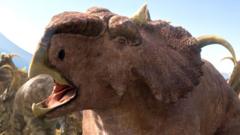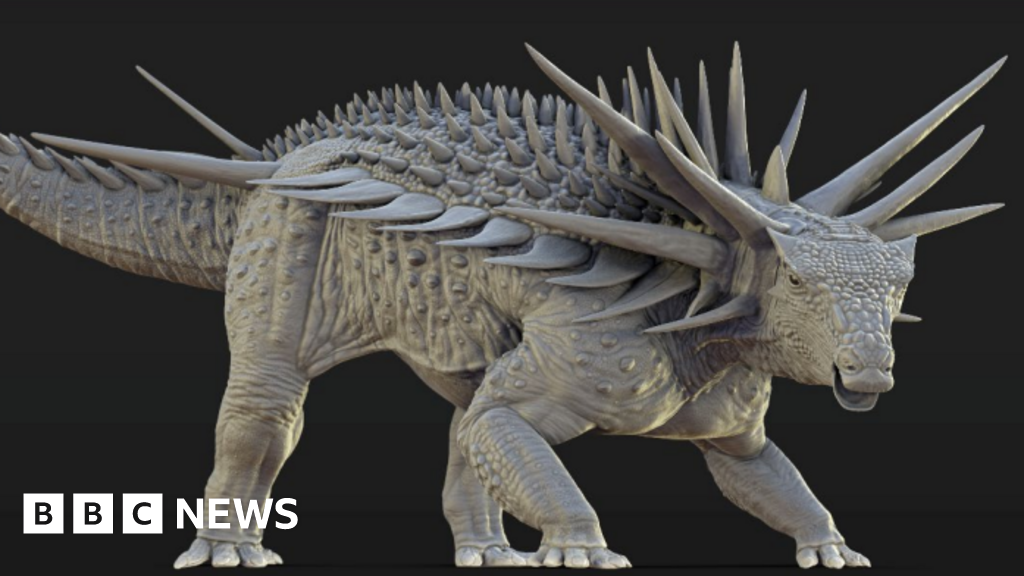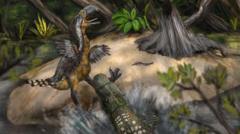The article text:
Nestled within the greenery of Alberta, Canada, lies a prehistoric graveyard where the remains of countless dinosaurs rest, forever encased in stone. Known as Pipestone Creek, or the "River of Death," this remarkable site is drawing the attention of palaeontologists eager to unravel the mystery surrounding a mass extinction that took place 72 million years ago.
Led by Professor Emily Bamforth, the excavation team has only just begun to crack open the dense layers of rock that safeguard what she labels "palaeo gold." With each strike of the sledgehammer, the robust bones of Pachyrhinosaurus start to emerge, providing an insightful glimpse into this ancient world. "This big blob of bone we presume is part of a hip," Professor Bamforth points out, while her canine companion Aster remains vigilant for nearby bears.
As the excavation progresses, the staggering number of fossils found suggests that this site is perhaps one of the greatest in North America, with estimates indicating up to 300 bones per square meter. “It is jaw-dropping,” Bamforth states, underscoring the unique nature of this find.
This extraordinary gathering of fossils provides an unparalleled view of a migratory herd, believed to have journeyed over vast distances in search of food during a warmer climate period. "It is a snapshot in time featuring a single species, which is a rare find in paleontology," explains Bamforth, highlighting the importance of this site for understanding the dynamics of prehistoric communities.
In a nearby location, known as the Deadfall Hills, larger dinosaur fossils, including those of the Edmontosaurus, offer further clues about the rich biodiversity of this area. The team is working diligently at the Philip J Currie Dinosaur Museum in Grande Prairie, where the bones, including a sizeable Pachyrhinosaurus skull known as "Big Sam," are cleaned and analyzed. Each discovery enhances our knowledge about dinosaur biology and allows researchers to delve into the variations within the species.
However, the central question looms: how did so many dinosaurs perish at once? According to Professor Bamforth's research, they were likely victims of a sudden catastrophic event, possibly a flash flood triggered by a storm that swept through the mountains, leading to a devastating onslaught of water and debris. The evidence suggests that the Pachyrhinosaurus, being heavily built and not particularly adept at swimming, would have been unable to escape this torrent.
In the aftermath of such a cataclysmic event, the geological formations at the site reveal intriguing patterns of sediment and destruction frozen in time. These clues not only denote a tragic day for the dinosaurs but serve as a goldmine for scientific study.
As researchers continue to unearth and analyze these ancient remains, they express their commitment to returning to the site. Each visit is guaranteed to yield new findings, and the anticipation of future discoveries keeps the team energized. With many more secrets trapped in the soil, the echoes of the past await their story to be told.
The highly anticipated BBC series, Walking With Dinosaurs, set to premiere on May 25, will showcase these remarkable findings and dive deeper into the prehistoric ecosystems that characterized Alberta millions of years ago.
Nestled within the greenery of Alberta, Canada, lies a prehistoric graveyard where the remains of countless dinosaurs rest, forever encased in stone. Known as Pipestone Creek, or the "River of Death," this remarkable site is drawing the attention of palaeontologists eager to unravel the mystery surrounding a mass extinction that took place 72 million years ago.
Led by Professor Emily Bamforth, the excavation team has only just begun to crack open the dense layers of rock that safeguard what she labels "palaeo gold." With each strike of the sledgehammer, the robust bones of Pachyrhinosaurus start to emerge, providing an insightful glimpse into this ancient world. "This big blob of bone we presume is part of a hip," Professor Bamforth points out, while her canine companion Aster remains vigilant for nearby bears.
As the excavation progresses, the staggering number of fossils found suggests that this site is perhaps one of the greatest in North America, with estimates indicating up to 300 bones per square meter. “It is jaw-dropping,” Bamforth states, underscoring the unique nature of this find.
This extraordinary gathering of fossils provides an unparalleled view of a migratory herd, believed to have journeyed over vast distances in search of food during a warmer climate period. "It is a snapshot in time featuring a single species, which is a rare find in paleontology," explains Bamforth, highlighting the importance of this site for understanding the dynamics of prehistoric communities.
In a nearby location, known as the Deadfall Hills, larger dinosaur fossils, including those of the Edmontosaurus, offer further clues about the rich biodiversity of this area. The team is working diligently at the Philip J Currie Dinosaur Museum in Grande Prairie, where the bones, including a sizeable Pachyrhinosaurus skull known as "Big Sam," are cleaned and analyzed. Each discovery enhances our knowledge about dinosaur biology and allows researchers to delve into the variations within the species.
However, the central question looms: how did so many dinosaurs perish at once? According to Professor Bamforth's research, they were likely victims of a sudden catastrophic event, possibly a flash flood triggered by a storm that swept through the mountains, leading to a devastating onslaught of water and debris. The evidence suggests that the Pachyrhinosaurus, being heavily built and not particularly adept at swimming, would have been unable to escape this torrent.
In the aftermath of such a cataclysmic event, the geological formations at the site reveal intriguing patterns of sediment and destruction frozen in time. These clues not only denote a tragic day for the dinosaurs but serve as a goldmine for scientific study.
As researchers continue to unearth and analyze these ancient remains, they express their commitment to returning to the site. Each visit is guaranteed to yield new findings, and the anticipation of future discoveries keeps the team energized. With many more secrets trapped in the soil, the echoes of the past await their story to be told.
The highly anticipated BBC series, Walking With Dinosaurs, set to premiere on May 25, will showcase these remarkable findings and dive deeper into the prehistoric ecosystems that characterized Alberta millions of years ago.



















